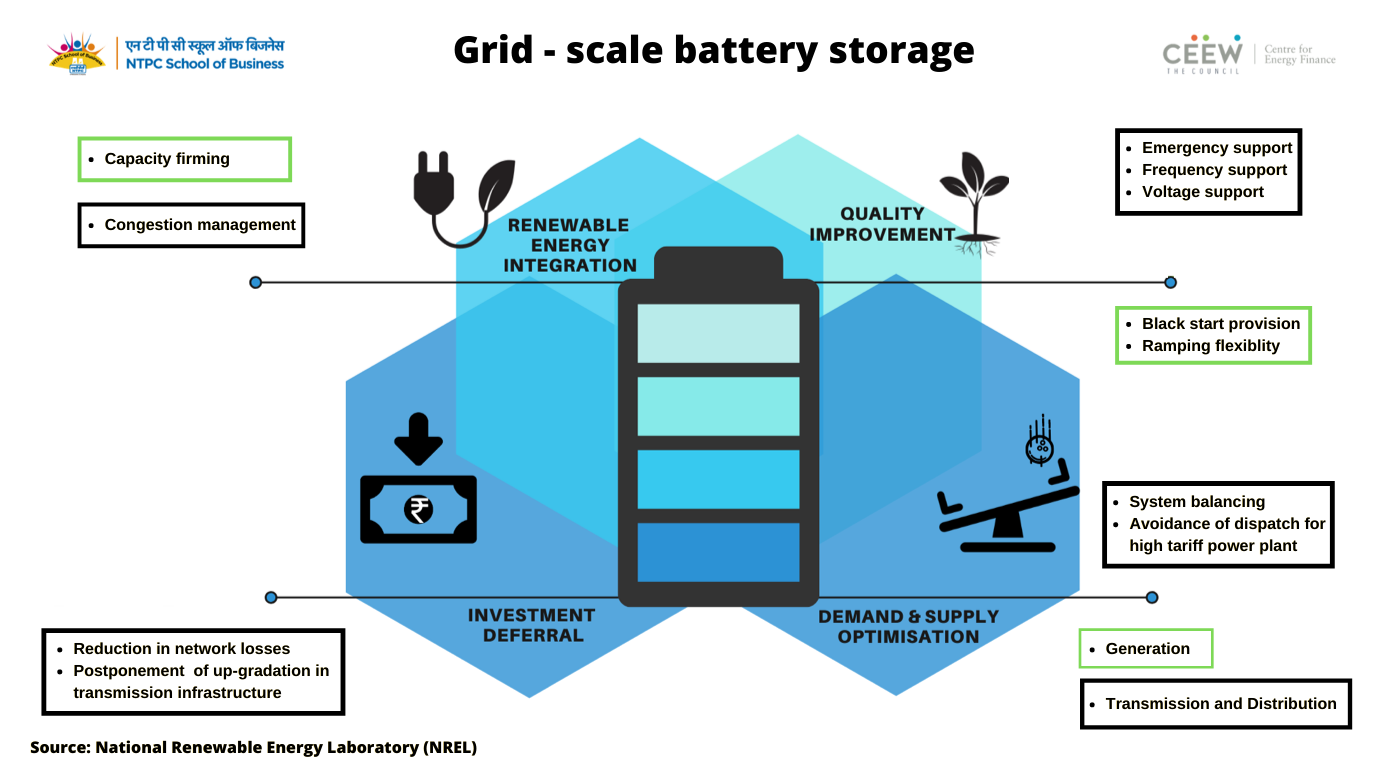Electrons travel at the speed of light and, hence, once electricity is generated, it must be consumed immediately. Therefore, the demand must be matched by the supply to ensure grid stability. However, with the development and commercialisation of new technologies, storing electricity instead of consuming it right away has become a reality.
India is currently undergoing an energy transition, with an increased share of renewable energy and the shift towards real-time electricity markets. These have exposed various players, particularly electric utilities and system operators, to more risks associated with system imbalances. Instances of power curtailment, and the need to ramp up or down power plants, have also increased.
Electricity stored in batteries is dispatchable, offers fast response times, and faces fewer technical restrictions when compared to typical generation sources. Therefore, battery storage can support several grid-level applications to effectively mitigate the risks mentioned above. The infographic shown below captures key applications of battery storage in the electricity grid.

The adoption of grid-scale battery storage has three main drivers in the Indian context, detailed below.
Lower upfront costs
Among battery technologies, lithium-ion has experienced more pronounced cost reductions in recent years compared to the advanced lead and flow battery technologies. In contrast, advanced lead and flow battery technologies have seen a modest cost reduction. Despite these cost reductions, these technologies still require the right set of incentives to make them commercially viable. Key incentives that may be adopted to promote installations include capacity payments, feed-in tariffs, investment tax credits, accelerated depreciation, etc.
Enabling regulatory framework
Grid-scale storage, being in its early stages, requires an enabling regulatory framework. In 2017, the Central Electricity Regulatory Commission released a staff paper on energy storage requirements for the Indian grid.1 A subsequent discussion paper in 2018 proposed a market mechanism for technology-agnostic ancillary services procurement.2 Once implemented, this mechanism is expected to create an appropriate regulatory framework for deploying grid-scale battery storage. In addition, the Indian Electricity Grid Code is in the process of being amended to deepen the market.
Successful demonstration in projects
As per a recent report by the Central Electricity Authority, the grid-scale battery storage market is estimated to grow to 108 GWh by the fiscal year 2029–30.3 India’s first grid-scale battery storage project was commissioned in February 2019 by Tata Power Delhi Distribution Limited (TPDDL, Delhi’s power distribution company). The project was built by Fluence (a partnership between American Electricity Supply and Mitsubishi Corporation). Since then, the year 2019–20 has seen a sharp increase in the number of grid-scale storage tenders owing to a strong push by government agencies.
Besides, the year has also witnessed many generation-storage tenders, constituting positive market signals for the deployment of grid-scale battery storage (see table below for details).
Table 1: Grid-scale storage tenders in India

Source: SECI, AP Transco, UHBVN, and DHBVN websites
Relevance and impact
Energy storage plays a crucial role in the power sector and impacts different parts of the value chain. Some of the use cases are:
- Distribution and transmission companies may mobilise storage to defer investment in the network and also minimise deviation settlement mechanism charges.
- They may further reduce renewable energy curtailment and its integration costs by procuring renewable energy firmed with storage.
- Power systems operators may utilise battery storage for voltage and frequency support (ancillary services) for tackling real-time mismatch between demand and supply.
- Merchant generators may mobilise storage to sell power to the short-term market and profit from price arbitrage.
Who should care about grid-scale battery storage technology?
- Power generators (renewable and conventional)
- Power systems operators
- Distribution companies
- Transmission companies
- Central and state regulatory commissions
References
- [1] “Staff Paper on Introduction of Electricity Storage System in India”, CERC, January 2017,
- http://www.cercind.gov.in/2017/draft_reg/SP.pdf
- [2] “Discussion Paper on Re-designing Ancillary Services Mechanism in India”, CERC, September 2018,
- http://www.cercind.gov.in/2018/draft_reg/DP.pdf
- [3] “Report on Optimal Generation Capacity Mix for 2029-30”, CEA, January 2020,
- http://cea.nic.in/reports/others/planning/irp/Optimal_mix_report_2029-30_FINAL.pdf
